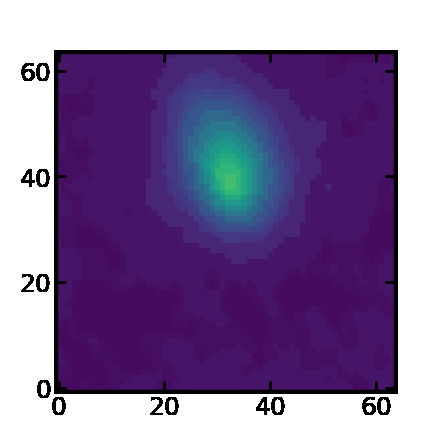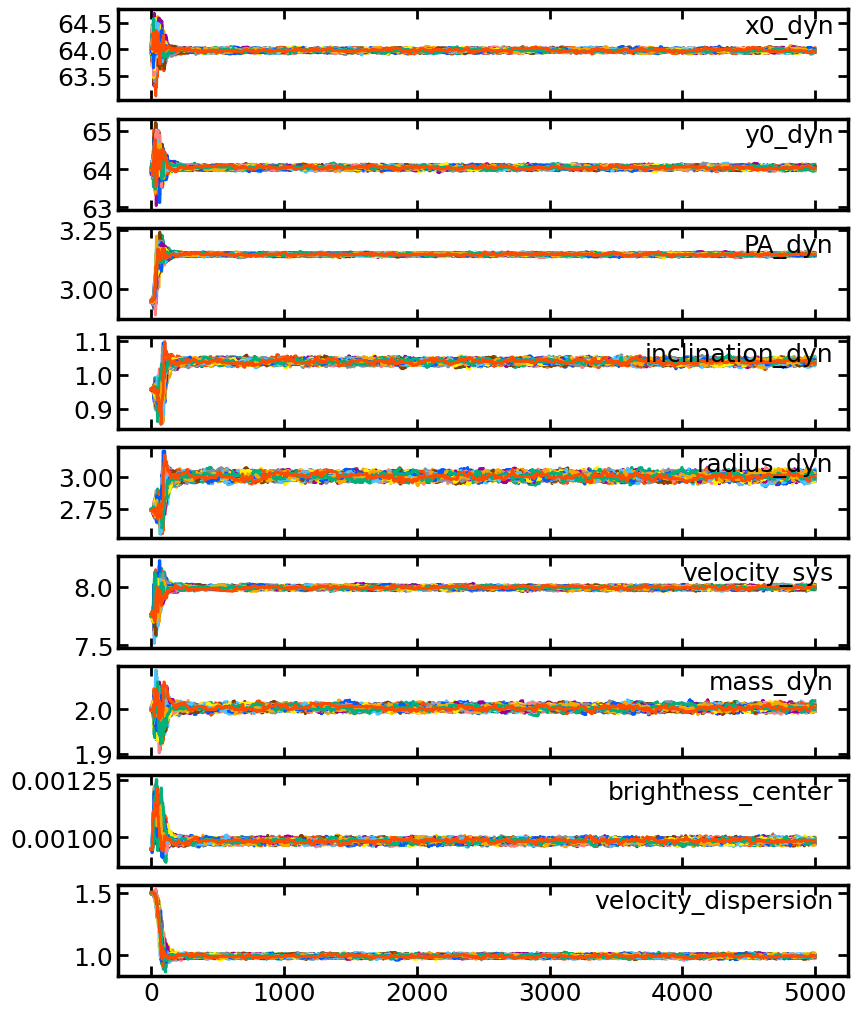Visualization
This visualization tutorial uses an instance tok and sol
obtained by fitting the tutorial data according to
Getting Started.
Moment 0 map
Cube.moment0() reutrns the moment-0 (integrated-flux) map of the
data cube. The best-fit model cube is stored in the tok as
tok.modelcube. We can visually compare the data and model using
tok.datacube and tok.modelcube.
import matplotlib.pyplot as plt
fig, axes = plt.subplots(1, 3, figsize=[6.28 * 3, 6.28])
axes[0].imshow(tok.datacube.moment0(), origin='lower')
axes[1].imshow(tok.modelcube.moment0(), origin='lower')
axes[2].imshow(tok.datacube.moment0() - tok.modelcube.moment0(), origin='lower')

Moment 1 map
Similar to the moment-0 map, DataCube.pixmoment1() reutrns the
moment-1 (velocity) map of the data cube.
import matplotlib.pyplot as plt
thresh = 3 * tok.datacube.rms_moment0()
v_center = np.nanmean(tok.datacube.pixmoment1(thresh=thresh))
m1_data = tok.datacube.pixmoment1(thresh=thresh) - v_center
m1_model = tok.modelcube.pixmoment1(thresh=thresh) - v_center
fig, axes = plt.subplots(1, 3, figsize=[6.28 * 3, 6.28])
axes[0].imshow(m1_data, origin='lower', cmap='coolwarm')
axes[1].imshow(m1_model, origin='lower', cmap='coolwarm')
axes[2].imshow(m1_data - m1_model, origin='lower', cmap='coolwarm')

Cube animation
There are several ways (including those not written in this section) to illustrate a 3D cube on python.
On the plot viewer, you can use matplotlib.pyplot.pause() to make
animation of a 3D cube. This example shows the flux maps along the
velocity axis.
import matplotlib.pyplot as plt
interval = 0.05
vsize = tok.datacube.vlim[1] - tok.datacube.vlim[0]
data = tok.datacube.imageplane
fig = plt.figure()
for i in range(vsize):
plt.imshow(data[i, :, :], origin='lower', vmin=data.min(), vmax=data.max())
plt.pause(interval)
fig.clear()
plt.clf()
plt.clf()
plt.close()
To save the animation in a file, matplotlib.animation is an option.
import matplotlib.pyplot as plt
import matplotlib.animation as animation
cube = tok.datacube.imageplane
vmin, vmax = cube.min(), cube.max()
fig = plt.figure(figsize=[6.28 * 0.7, 6.28 * 0.7])
ax = fig.add_subplot(1, 1, 1)
ims = []
for i in range(len(cube[:, 0, 0])):
im = ax.imshow(cube[i, :, :], vmin=vmin, vmax=vmax, origin='lower')
ims.append([im])
ani = animation.ArtistAnimation(
fig, ims, interval=300, blit=False, repeat_delay=1000, repeat=True
)
ani.save('anime_cube.gif', writer='pillow')
plt.close()

…why does this animation have so poor image quality?
Convergence of MCMC sampler
The MCMC sampler during the MCMC fitting are stored in the solution,
sol.sampler. You can check whether the MCMC fiting is converged
using this attribute.
Note
Even if you performed fitting with the methods other than MCMC, there
exists sol.sampler, but None is stored.
This code plots the behavior of the nine parameters at each step.
import matplotlib.pyplot as plt
samples = sol.sampler.get_chain()
label = sol.best._fields
fig, axes = plt.subplots(9, 1, figsize=[6.28 * 1.5, 6.28 * 2])
for i in range(9):
axes[i].plot(samples[:, :, i])
axes[i].text(0.98, 0.95, label[i], ha='right', va='top', transform = axes[i].transAxes)
if i != 8:
axes[i].xaxis.set_ticklabels('')

Tokult implement emcee as a MCMC sampler, so please see the
emcee document for the details of how to manipulate the sampler.